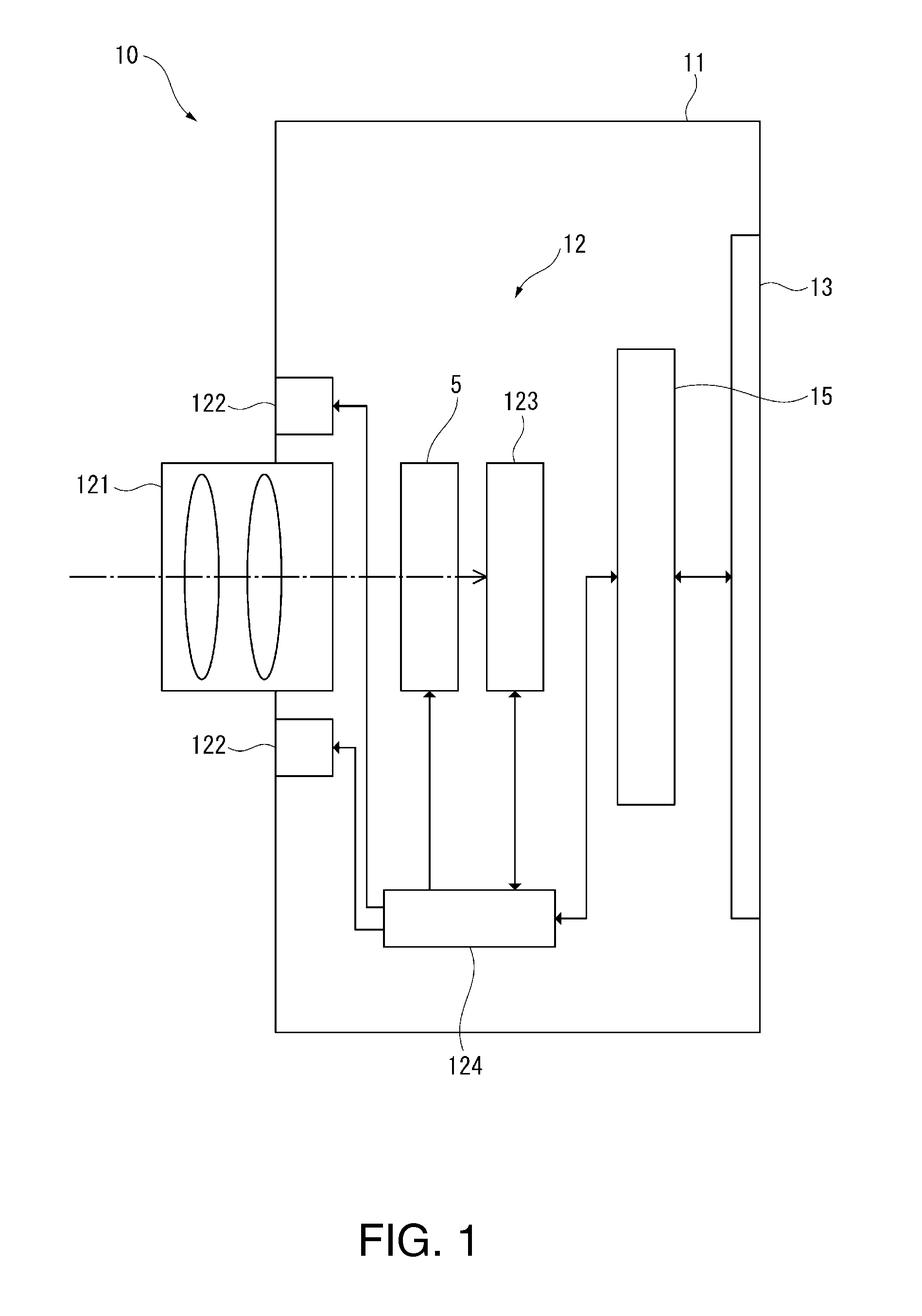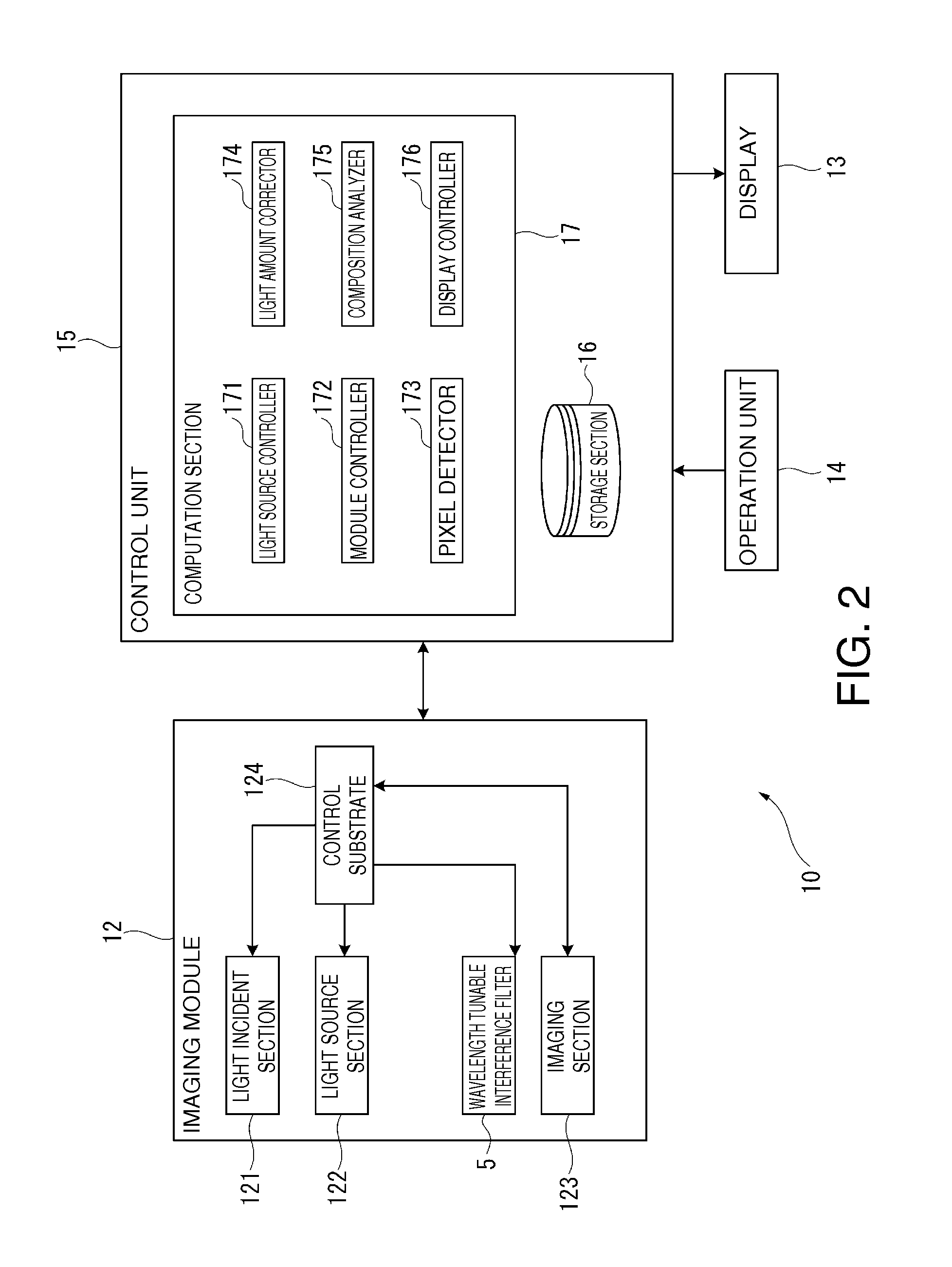Camera and image processing method for spectroscopic analysis of captured image
a spectroscopic analysis and image technology, applied in the field of cameras and image processing methods, can solve the problems of large error, abnormal brightness of parts of a spectroscopic image, short distance between the light source and the imaging lens, etc., and achieve the effect of high-precision imag
- Summary
- Abstract
- Description
- Claims
- Application Information
AI Technical Summary
Benefits of technology
Problems solved by technology
Method used
Image
Examples
first embodiment
[0047]A spectroscopic analysis apparatus (camera) of a first embodiment according to the invention will be described below with reference to the drawings.
Schematic Configuration of Spectroscopic Analysis Apparatus
[0048]FIG. 1 is a schematic view showing a schematic configuration of the spectroscopic analysis apparatus of the first embodiment. FIG. 2 is a block diagram showing the schematic configuration of the spectroscopic analysis apparatus.
[0049]A spectroscopic analysis apparatus 10 is a camera according to an embodiment of the invention and an apparatus that captures spectroscopic images of an object being imaged at a plurality of wavelengths, analyzes a spectrum in an infrared wavelength region (target wavelength region in spectroscopic image) at each pixel based on the captured spectroscopic images, and analyzes the composition of the object being imaged based on the analyzed spectra.
[0050]The spectroscopic analysis apparatus 10 of the present embodiment includes an enclosure ...
second embodiment
[0145]A second embodiment according to the invention will next be described with reference to the drawings.
[0146]In the first embodiment described above, the amount of light at an abnormal pixel (i, j) in a spectroscopic image Pλk is replaced, by way of example, with a light amount correction value in the form of the average of the amounts of light at normal pixels in a predetermined pixel area including the abnormal pixel. The second embodiment differs from the first embodiment described above in that the light amount correction value is calculated in the form of the median of the amounts of light at normal pixels.
[0147]FIG. 10 is a flowchart showing the light amount correction process in the second embodiment.
[0148]In the following description, the same configurations as those in the first embodiment and the items having already been described in the first embodiment have the same reference characters and will not be described or described in a simplified manner.
[0149]In the prese...
third embodiment
[0160]A third embodiment according to the invention will next be described with reference to the drawings.
[0161]In the first and second embodiments described above, the average or median of the amounts of light at normal pixels is selected as the light amount correction value in step S100. The present embodiment differs from the first and second embodiments described above in that the average of the amounts of light at normal pixels in the quartile range is acquired.
[0162]FIG. 11 is a flowchart showing the light amount correction process in the third embodiment.
[0163]In the present embodiment, the light amount corrector 174 carries out the processes in steps S101 to S114 as in the second embodiment to sort the light amount sequence d_n(0) to d_n(c−1), which represent the amounts of light at normal pixels in a pixel area, to acquire a sorted sequence S_n(1) to S_n(c), as shown in FIG. 11.
[0164]Thereafter, in the present embodiment, the light amount corrector 174 calculates the light ...
PUM
 Login to View More
Login to View More Abstract
Description
Claims
Application Information
 Login to View More
Login to View More - R&D
- Intellectual Property
- Life Sciences
- Materials
- Tech Scout
- Unparalleled Data Quality
- Higher Quality Content
- 60% Fewer Hallucinations
Browse by: Latest US Patents, China's latest patents, Technical Efficacy Thesaurus, Application Domain, Technology Topic, Popular Technical Reports.
© 2025 PatSnap. All rights reserved.Legal|Privacy policy|Modern Slavery Act Transparency Statement|Sitemap|About US| Contact US: help@patsnap.com



